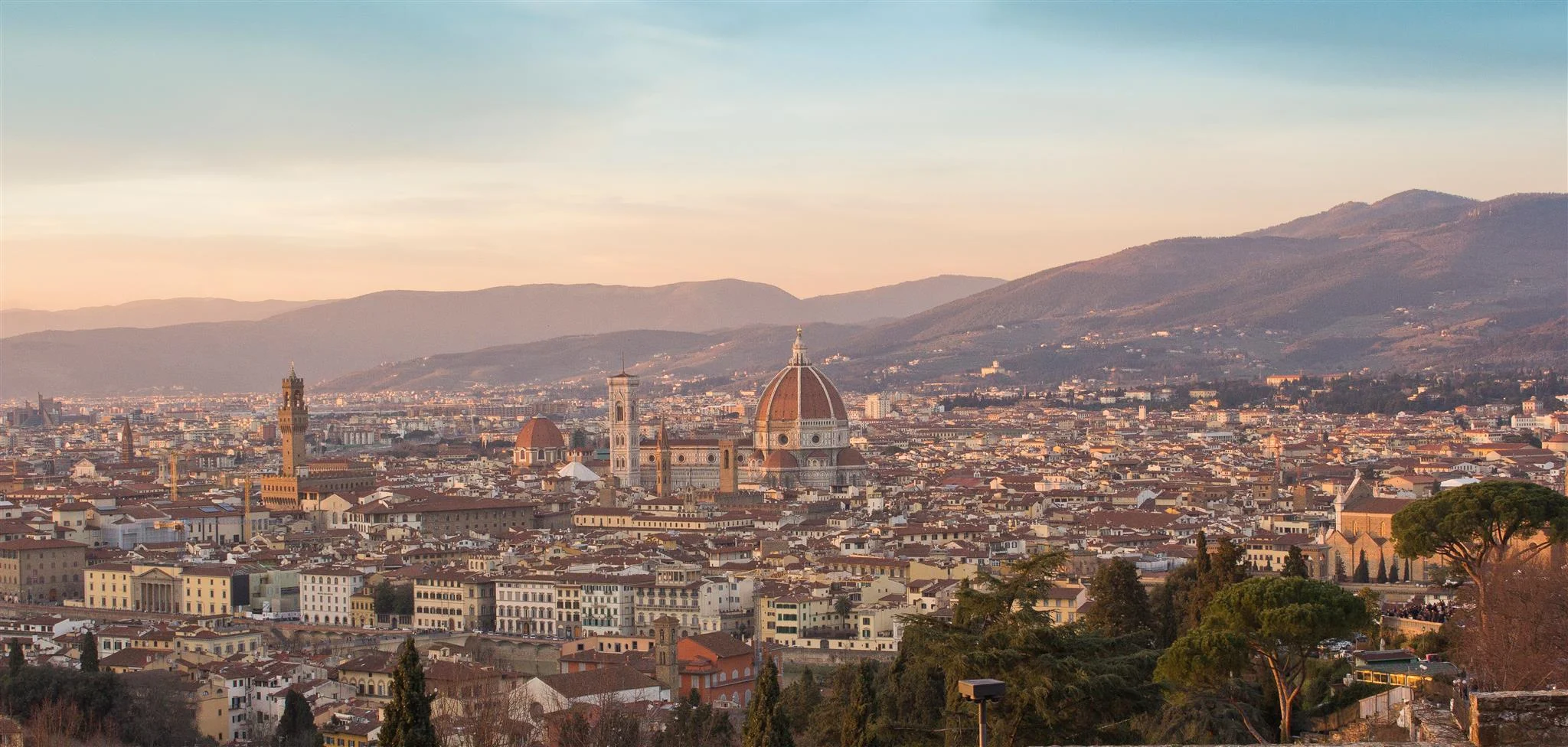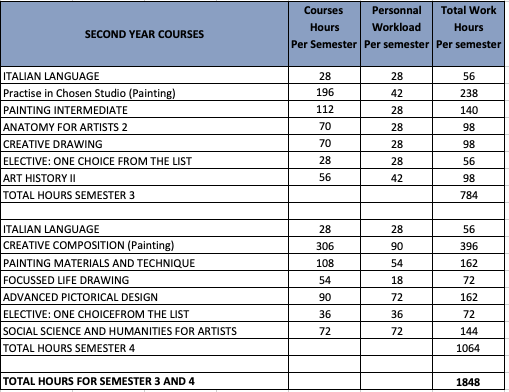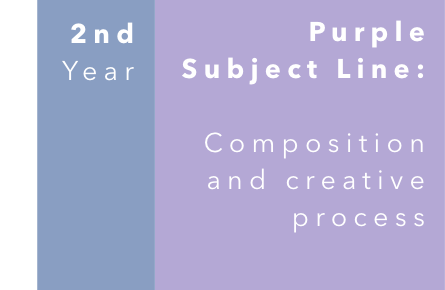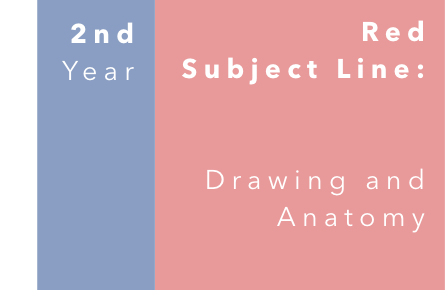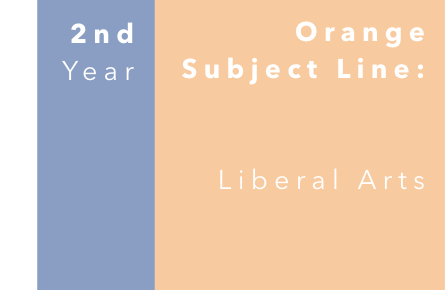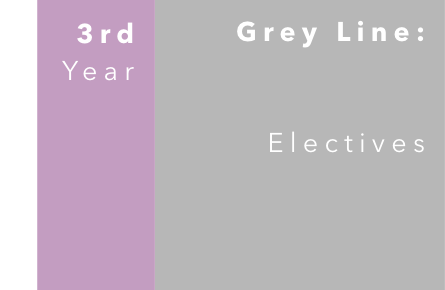The Bachelor of Fine Art (Painting) is a hybrid of university- level liberal arts topics with atelier-style skills training in representational art.
The programme is arranged in an innovative, integrated structure that aims to give the optimum learning experience for those aspiring to work as representational painters in the 21st century.
We ardently believe in the importance of strong training in the skills and knowledge involved in the representation of visual reality, as well as that of composing pictures and sculptures. To that end, the programme builds a solid foundation of these skills and knowledge in the first and second year, while guiding students gradually towards an ever-greater compositional, procedural and creative autonomy.
3 Year Bachelor Degree Programme
30 ECTS credits per semester
60 ECTS credits per year
180 ECTS credits per 3 Year Bachelor Degree Programme
First Year: Over the course of Semesters one and two, students acquire baseline knowledge and practical experience in the fundamentals of representation and the fundamentals of compositional design. This content is common to all plastic arts, and it is important that students recognise the unity of these skills and knowledge. The four categories of representational art that are dealt with in the academy are introduced and students are given the chance to experience working in each approach, leading towards the choice of which studio to specialise in, in the second year. Italian language is undertaken towards achieving a level of B2 competence which must be achieved by the end of the programme.
Read an introduction to the Subject Lines, by which the courses are organised.
Second Year: During the second year, fundamental training in drawing, anatomy, compositional principles and processes, and liberal arts topics will continue. Students will have decided on which studio to specialise in and their painting practise will be focussed on the particular processes, subjects and considerations relevant to that studio. Within the approach of their chosen studio, students will be expected to employ progressively more autonomy in the composing and development of their pictures over the course of the year. Learn more about the four studio approaches here. This will help to prepare the student for their major project in third year.
Third Year: Having progressed with both skills training and the specific approach in their chosen studio, students embark on their major final project in the third year. This project will be developed, under the guidance of teachers, over the duration of semesters five and six, and will be accompanied by a written thesis, which will serve to examine and highlight the works, both preparatory and executed, as well as the inspirations and relationships of the work to the world and art history.
Plastic design and compositional process: The fundamentals of linear, tonal and colour design will be covered, and students will participate in exercises utilising these principles in their own compositional sketches. Colour theory as it applies to the representation of light falling on form, will support the painting subject. The key processes for conceiving, developing and resolving compositions will be covered and students will apply these in simple form through sequential class exercises.
First Year: Drawing and Anatomy: Working from the model, students will study gestural form drawing as well as tonal drawing throughout the year. The fundamentals of perspective and simple forms will be covered and students will develop their capacity to build form from imagination, and use this in developing a thorough understanding of the structure of the human head. Artistic anatomy will be studied throughout the year, beginning with a simplified overview écorché (flayed anatomical figure) course in first semester and leading to the first stage of a detailed écorché course (the skeleton) in second semester.
Liberal Arts: Students will study art history during the first semester and philosophy in the second semester. Overviews of these areas will be followed by more in-depth lectures. These will be, where possible, surveys across topics, for instance the type of poses used in art by various cultures throughout history, or a comparison of various important aesthetic philosophies. This promotes the engagement of the critical thinking of students, who will be encouraged to derive their own conclusions and be actively involved in the content being conveyed and guided by the lecturer.
Painting: Students will develop experience with oil paint as they cover the fundamentals of light falling on form, both in monochrome and in colour. This will involve painting from plaster casts, still life and the figure, with each subject building on the last, and exercises in visualising from imagination to ensure this knowledge is internalised rather than passively observed.
Second language study will begin in Semester 1
Students must have competence in English plus a second European language by the end of their study.
Italian is recommended for anyone not a native speaker of the this language, and lessons in Italian are included in our syllabus. Italian is highly recommended since we are located in Italy and this beautiful language provides many benefits in art history and contemporary arts based in Italy, as well as enhancing your experience of living here. B2 competency is required by the end of the 6th Semester.
Non-native English speakers are required to take a test of English as a Foreign Language in order to validate the European Bachelor. This test may be taken after completion of the course, but it is a strict requirement, and we recommend taking the test during the course. The required level of competence is TOEIC 660-745 (which is up to B2)
For Italian study, 2 levels of study are offered, depending on the student’s experience with Italian.
Semester 1:
Semester 2:
Electives: Each semester, students are able to choose between 2 or 3 different options for elective courses. Note that elective subjects that do not receive sufficient enrolment by the start of the semester will be cancelled, and any enrolled students will be asked to choose a different elective course.
Semester 1: Choose 2 out of the 3 options below:
Semester 2: Choose 1 out of the 2 options below:
Plastic design and compositional process: During the third semester, students will apply the lessons from the previous two semesters in more experimental exercises. This will be followed by compositional activities specifically related to the studio that the student has selected to specialise in.
Drawing and Anatomy: Students will complete the detailed écorché (flayed anatomical figure) begun during Semester 2 by adding the soft tissues to the skeleton. Drawing class will specialise into approaches relevant to the studio that the student has selected.
Liberal Arts: During the third semester, students will continue their study of art history, with a particular emphasis on the 20th and 21st century, including a history of representational art running in parallel to the more celebrated modernist artists of this period. In the fourth semester, students will be introduced to a variety of subjects from the social sciences including anthropology, psychology, and sociology and aspects of these that might be of particular relevance to representational artists today. This will include navigating the complex contemporary art market and the world as a representational artist. Also covered will be topics that have a historical precedent of being creatively stimulating for the artist, for example, Jungian archetypes, or human evolution.
Painting: Painting projects will specialise to the studio chosen by the student at the end of Semester 2, beginning with more exercises to unpack the studio approach further in the third semester, and followed by more creative and more autonomous projects within the scope of the studio in the fourth semester.
Second language study (Italian for non-native speakers) will continue.
Students must have competence in English plus a second European language by the end of their study.
Italian is recommended for anyone not a native speaker of the this language, and lessons in Italian are included in our syllabus. Italian is highly recommended since we are located in Italy and this beautiful language provides many benefits in art history and contemporary arts based in Italy, as well as enhancing your experience of living here. B2 competency is required by the end of the 6th Semester.
Non-native English speakers are required to take a test of English as a Foreign Language in order to validate the European Bachelor. This test may be taken after completion of the course, but it is a strict requirement, and we recommend taking the test during the course. The required level of competence is TOEIC 660-745 (which is up to B2)
For Italian study, 2 levels of study are offered, depending on the student’s experience with Italian.
Italian language B2 competency is required by the end of the 6th Semester and study is compulsory unless this level has already been achieved.
2 levels of study are offered, depending on the student’s experience with Italian. Students who have completed Beginner 1 and 2 will proceed to Intermediate 1, while more experienced students who have already completed Intermediate 1 and 2 will proceed to Advanced 1.
Semester 3:
Semester 4
Electives: Each semester, students are able to choose between 2 or 3 different options for elective courses. Note that elective subjects that do not receive sufficient enrolment by the start of the semester will be cancelled, and any enrolled students will be asked to choose a different elective course.
Semester 3: Choose 2 out of the 3 options below:
Semester 4: Choose 1 out of the 2 options below:
Painting: Throughout the third year, students will be guided to conceive, explore, execute and resolve their major project, within the scope of the studio in which they have been specialising. Regular feedback from painting teachers and small, regular, guided critique sessions with fellow students, will help each person to develop their ideas and improve their capacity for communication about their own artwork and the constructive critique of others’ work.
Second language study will continue the second year (Italian for non-native speakers).
Students must have competence in English plus a second European language by the end of their study.
Italian is recommended for anyone not a native speaker of the this language, and lessons in Italian are included in our syllabus. Italian is highly recommended since we are located in Italy and this beautiful language provides many benefits in art history and contemporary arts based in Italy, as well as enhancing your experience of living here. B2 competency is required by the end of the 6th Semester.
Non-native English speakers are required to take a test of English as a Foreign Language in order to validate the European Bachelor. This test may be taken after completion of the course, but it is a strict requirement, and we recommend taking the test during the course. The required level of competence is TOEIC 660-745 (which is up to B2)
For Italian study, 2 levels of study are offered, depending on the student’s experience with Italian.
Anyone who has not yet completed the Advanced 1 and 2 courses will continue towards achieving a level of B2 competency by the end of the year.
Semester 5:
Semester 6:
Electives: Each semester, students are able to choose between 2 or 3 different options for elective courses. Note that elective subjects that do not receive sufficient enrolment by the start of the semester will be cancelled, and any enrolled students will be asked to choose a different elective course.
Semester 5: Choose 2 out of the 3 options below:
Semester 6: Choose 1 out of the 2 options below
